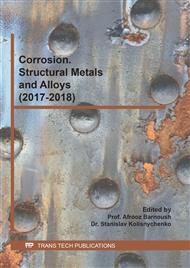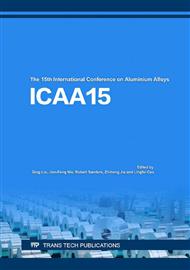p.461
p.471
p.479
p.485
p.492
p.498
p.508
p.514
p.522
Intergranular Corrosion Mechanism of Brazed Al-Mn-Cu-Si Alloy
Abstract:
This paper investigated the effect of Si addition on intergranular corrosion susceptibility for brazed Al–Mn–Cu alloy. Water-quenched samples have no intergranular corrosion (IGC) susceptibility, however, slowly cooled samples have IGC susceptibility. This implies that IGC susceptibility was caused by precipitation during cooling. In addition, IGC susceptibility depends on Si content. Low Si additive alloy has high IGC susceptibility. This is because the Mn/Cu depleted zone is formed near the grain boundary due to preferential precipitation of Mn-bearing compound and CuAl2 on the grain boundary. Conversely, optimum Si addition inhibits IGC due to the absence of preferential precipitation on the grain boundary. The excess Si alloy has high IGC susceptibility as the Si depleted zone is formed around the grain boundary due to the preferential precipitation of coarse Si particles on the grain boundary.
Info:
Periodical:
Pages:
492-497
Citation:
Online since:
November 2016
Authors:
Price:
Сopyright:
© 2017 Trans Tech Publications Ltd. All Rights Reserved
Share:
Citation:



